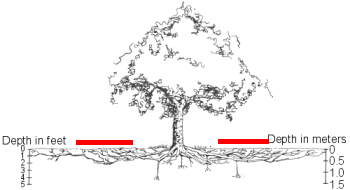
Tree roots extend past the dripline
 Now that we're home from our
journey, it's time to bring my obsession with Robert Kourik's book to
an end too. Where better to end than with my greatest weakness
--- fruit trees?
Now that we're home from our
journey, it's time to bring my obsession with Robert Kourik's book to
an end too. Where better to end than with my greatest weakness
--- fruit trees?
Robert Kourik's book
threw everything I thought I knew about fruit trees on its head.
You know how the roots of trees extend as far vertically and
horizontally underground as the tree's canopy spreads
aboveground? That's bunk. In fact, tree roots often grow
1.5 to 3 times as wide as the canopy of the tree. And while some
vertical roots sink deep to give the tree stability, the majority of
the tree's feeding is done in the top two to four feet of the soil,
with the primary focus on the top few inches.
What does this mean for
folks planting a little orchard in their backyard? Many of us
mulch our trees to prevent them from having to compete with grass for
nutrients --- if we do that, we should be mulching much further out
than the cute donut around the trunk. In fact, Kourik recommends
planting a cover crop close to the trunk of the tree and instead
focusing your mulch on the area halfway between the trunk and the
dripline of the tree, then continuing the same distance beyond the
dripline of the tree. (I've marked this area with a red line in
the diagram above.)
If all of this talk of
roots has whetted your appetite like it has mine, you might want to
check out one of Robert Kourik's more recent books --- Roots
Demystified.
My copy is already on hold through the interlibrary loan system.
This post is part of our lunchtime series reviewing Robert Kourik's Designing and Maintaining your
Edible Landscape Naturally.
Read all of the entries:
|
Want more in-depth information? Browse through our books.
Or explore more posts by date or by subject.
About us: Anna Hess and Mark Hamilton spent over a decade living self-sufficiently in the mountains of Virginia before moving north to start over from scratch in the foothills of Ohio. They've experimented with permaculture, no-till gardening, trailersteading, home-based microbusinesses and much more, writing about their adventures in both blogs and books.
Want to be notified when new comments are posted on this page? Click on the RSS button after you add a comment to subscribe to the comment feed, or simply check the box beside "email replies to me" while writing your comment.
